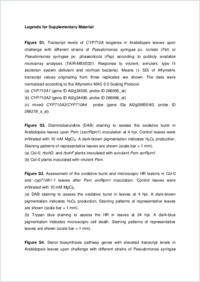A role for β-sitosterol to stigmasterol conversion in plant–pathogen interactions
- Griebel, Thomas Julius-von-Sachs-Institute of Biological Sciences, University of Würzburg, Germany
- Zeier, Jürgen Department of Biology, Plant Biology Section, University of Fribourg, Switzerland
-
26.04.2010
Published in:
- The Plant Journal. - 2010, vol. 63, no. 2, p. 254–268
English
Upon inoculation with pathogenic microbes, plants induce an array of metabolic changes that potentially contribute to induced resistance or even enhance susceptibility. When analysing leaf lipid composition during the Arabidopsis thaliana–Pseudomonas syringae interaction, we found that accumulation of the phytosterol stigmasterol is a significant plant metabolic process that occurs upon bacterial leaf infection. Stigmasterol is synthesized from β-sitosterol by the cytochrome P450 CYP710A1 via C22 desaturation. Arabidopsis cyp710A1 mutant lines impaired in pathogen-inducible expression of the C22 desaturase and concomitant stigmasterol accumulation are more resistant to both avirulent and virulent P. syringae strains than wild-type plants, and exogenous application of stigmasterol attenuates this resistance phenotype. These data indicate that induced sterol desaturation in wild-type plants favours pathogen multiplication and plant susceptibility. Stigmasterol formation is triggered through perception of pathogen-associated molecular patterns such as flagellin and lipopolysaccharides, and through production of reactive oxygen species, but does not depend on the salicylic acid, jasmonic acid or ethylene defence pathways. Isolated microsomal and plasma membrane preparations exhibited a similar increase in the stigmasterol/β-sitosterol ratio as whole-leaf extracts after leaf inoculation with P. syringae, indicating that the stigmasterol produced is incorporated into plant membranes. The increased contents of stigmasterol in leaves after pathogen attack do not influence salicylic acid-mediated defence signalling but attenuate pathogen-induced expression of the defence regulator flavin-dependent monooxygenase 1. P. syringae thus promotes plant disease susceptibility through stimulation of sterol C22 desaturation in leaves, which increases the stigmasterol to β-sitosterol ratio in plant membranes.
- Faculty
- Faculté des sciences et de médecine
- Department
- Département de Biologie
- Language
-
- English
- Classification
- Biological sciences
- License
-
License undefined
- Identifiers
-
- RERO DOC 20323
- DOI 10.1111/j.1365-313X.2010.04235.x
- Persistent URL
- https://folia.unifr.ch/unifr/documents/301591
Other files
Statistics
Document views: 142
File downloads:
- pdf: 394
- Supplementary material: 116

